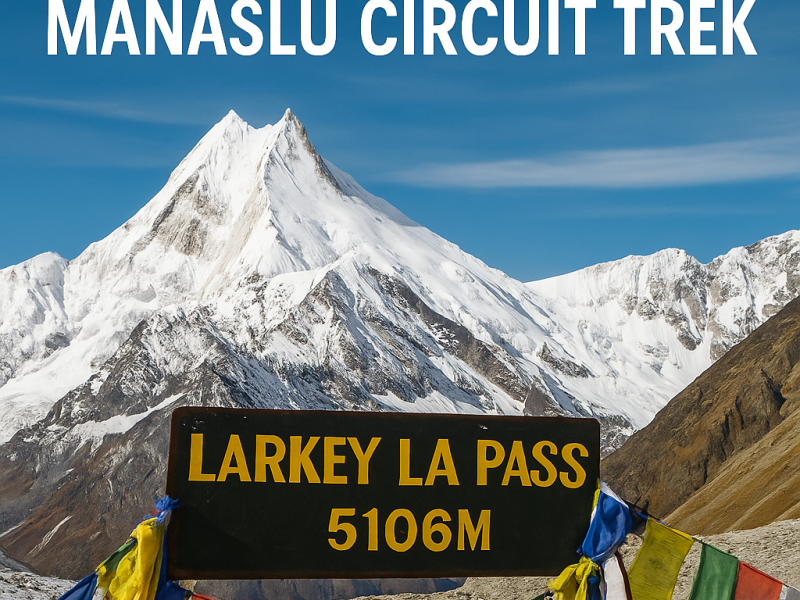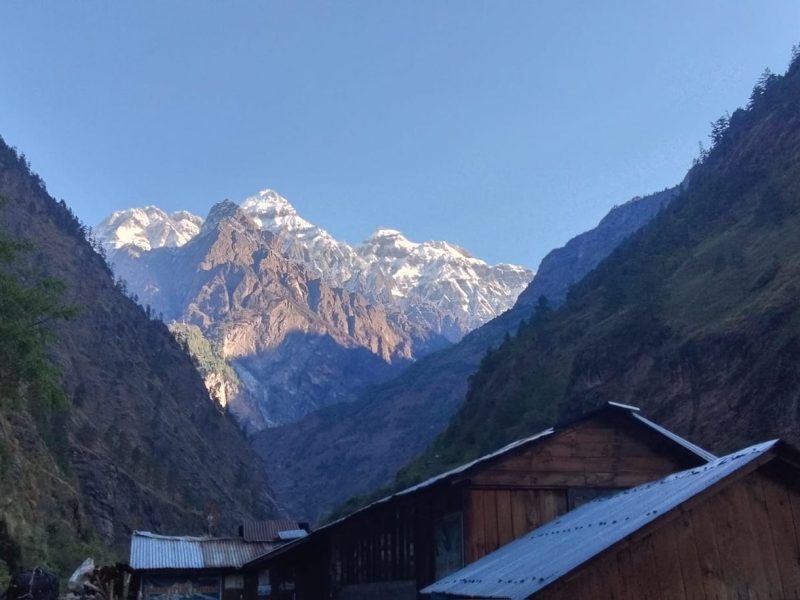
The Manaslu Circuit Trek is one of the most beautiful and remote trekking routes in Nepal. It goes around Mount Manaslu (8,163 m), the world’s eighth-highest peak. Along the way, trekkers pass through peaceful villages, ancient monasteries, deep valleys, and high mountain passes. The region is less crowded than the Everest Base Camp Trek or Annapurna Circuit, which makes it feel more natural and untouched. For photographers, this trek is a perfect mix of mountain landscapes, cultural heritage, and Himalayan wildlife.
For anyone who loves photography, the Manaslu region is like a paradise. Every day brings something new – snow-capped peaks, waterfalls, terraced fields, yak caravans, and smiling villagers in traditional dress. The sunrise and sunset views over the Himalayas are magical. You can capture rare wildlife like Himalayan tahr, blue sheep, or colorful birds, along with daily life in Tibetan-style villages. The changing scenery – from green forests to alpine deserts – gives photographers endless opportunities to tell a visual story.
But photography here is more than just taking pictures. It is also about respecting the local people, culture, and nature. Trekkers should always ask before taking portraits of villagers, avoid disturbing wildlife, and follow eco-friendly practices. A photo can become a memory for life, but it should never harm the environment or hurt local traditions. With the right care, your photos from the Manaslu Circuit Trek will not only remind you of the journey but also share the beauty and culture of this hidden Himalayan treasure with the world.
When trekking in the Manaslu region, having the right photography gear makes a big difference. Many trekkers choose between DSLR, mirrorless, action cameras, and drones. A DSLR gives you high image quality but is heavy. A mirrorless camera is lighter and easier to carry, making it great for high-altitude trekking. Action cameras like GoPro are small, waterproof, and strong, perfect for videos and quick shots. Drones can capture amazing aerial views, but they are not allowed everywhere in Nepal, so always check the rules before carrying one.
For lenses, wide-angle lenses are best for capturing big mountain landscapes, valleys, and villages along the Manaslu Circuit Trek. A telephoto lens is very useful for wildlife photography (like spotting blue sheep or Himalayan birds) and also for portraits of local people. If you want to travel light, carry one zoom lens that covers both wide and telephoto ranges. Along with lenses, don’t forget a tripod for sunrise and sunset shots, filters for controlling light, and plenty of memory cards for storing photos.
Since the Manaslu Trek is long and remote, power management is very important. Carry extra batteries because the cold drains them fast. A power bank or a small solar charger helps keep your camera and phone charged in villages where electricity may be limited. Always pack light — avoid carrying too much gear because high altitude makes every kilo feel heavier. Choose only the most important items and keep your bag balanced. With the right photography equipment and smart packing tips, you can capture the beauty of the Manaslu Circuit Trek without any stress.
The Manaslu Circuit Trek is full of amazing places for photography. From the first day, the trail gives you beautiful river valleys, green hills, and suspension bridges between small villages. The stretch from Arughat to Jagat is perfect for taking pictures of rural Nepal. You can capture farmers working in terraced fields, children playing in villages, and long suspension bridges over the Budhi Gandaki River. These early shots highlight the natural beauty and culture of the lower Manaslu region.
As you trek higher, the views become even more dramatic. Villages like Deng, Namrung, and Lho are full of monasteries, colorful prayer flags, and long mani walls. The traditional houses, local people in their cultural dress, and the backdrop of snow-covered peaks make this area a dream for photographers. Here, you can also capture the first clear mountain views of Himalchuli, Ganesh Himal, and Mt. Manaslu itself. Early morning light makes the photos especially magical.
The most iconic shots come from Samagaon, Birendra Tal, and Larkya La Pass. Samagaon is a picture-perfect village with Mt. Manaslu rising behind it. Birendra Tal is a turquoise glacial lake where the reflection of mountains makes a stunning scene. Finally, crossing Larkya La Pass (5,160 m) offers one of the best photography moments of the trek — a wide view of the Himalayas at sunrise. The snowy landscapes, high passes, and panoramic mountain views will give you some of the most memorable photos of your journey.
The Manaslu Circuit Trek is not only about mountains and landscapes—it is also about the people and culture that make this region so special. Along the trail, you will pass through local villages filled with stone houses, terraced fields, and smiling faces. Many of these villages are influenced by Tibetan culture, with beautiful monasteries, prayer wheels, and colorful prayer flags fluttering in the wind. These cultural symbols add depth and meaning to your photographs, showing the spiritual and traditional side of life in the Himalayas.
When photographing people, always remember to do it with respect. Locals may feel shy or private, so it is important to ask for permission before taking their portrait. A simple smile or friendly greeting can help build trust and make your pictures more natural. Portrait photography works best when you capture people in their real surroundings—like farmers working in the fields, children playing in the villages, or monks praying in monasteries. These small but powerful moments show the true heart of the Manaslu region.
Festivals, rituals, and daily life are also wonderful subjects for photography. Villagers often celebrate with dances, traditional dress, and religious ceremonies that bring the community together. Capturing these events can tell strong stories, but always balance storytelling with cultural sensitivity. Do not interrupt rituals or get too close during private moments. Instead, try to be part of the atmosphere, observing and capturing it naturally. By respecting the people and their traditions, your photos will not only look beautiful but will also carry meaning and honesty.
The Manaslu region is a dream destination for wildlife and nature photography. Trekkers often come across rare animals like the Himalayan tahr, blue sheep, and sometimes even signs of the snow leopard. While spotting these creatures in the wild can be a challenge, capturing them with a camera is a rewarding experience. Photographers should be patient, move quietly, and use telephoto lenses to photograph wildlife without disturbing them. This makes the Manaslu Circuit Trek not only an adventure but also a chance to record rare Himalayan species in their natural environment.
Bird lovers will also find Manaslu very special. The forests and high cliffs are home to the Himalayan monal (Danphe), Nepal’s national bird, with its rainbow-colored feathers. You may also see eagles, vultures, and other raptors flying above the valleys. These birds are perfect subjects for photography, especially when they soar against the backdrop of snow-covered peaks. A fast camera shutter helps capture their wings in motion, creating beautiful wildlife photography memories.
The landscapes of Manaslu are equally photogenic. In spring, the trails bloom with rhododendron forests, adding vibrant red and pink colors to your pictures. In the higher regions, wide alpine meadows with yaks and stone houses provide a natural frame for cultural and scenic photography. Trekkers should always stay respectful of nature—keep a safe distance from animals, avoid making noise, and never damage plants or habitats. This way, photography in Manaslu remains safe, eco-friendly, and deeply rewarding for every trekker.

When trekking in the mountains, photographers face many practical challenges. The first one is altitude, cold, and weather. At high altitudes, the air is thinner and temperatures drop quickly, especially at night or in shaded areas. Cold weather drains camera batteries very fast, so it’s good to carry extra batteries and keep them warm inside your jacket pockets. Sudden changes in weather like snow, rain, or wind can also affect your camera, so always be prepared with protective gear. Keywords: altitude photography, cold weather camera care, trekking photography tips.
Another big challenge is protecting your gear from dust, snow, and moisture. On trekking trails, dust can enter your camera while walking on dry paths, and snow or rain can damage it in wet conditions. Always carry your camera in a weather-sealed bag or use a dry bag when crossing rivers or in heavy rain. Lens filters and rain covers are useful to protect the lens. When inside tea houses, let your camera adjust slowly to room temperature to avoid fogging. Keywords: camera protection trekking, dust and moisture safety, photography gear care.
For power and timing, charging facilities in tea houses are limited and sometimes expensive. Carrying a power bank or solar charger is very helpful on long treks. Always plan to recharge your batteries whenever you find a chance. For beautiful shots, timing is very important. The best light is usually during the golden hour — early morning and late afternoon. After storms, the sky often clears, offering amazing views of the mountains. Each season gives unique highlights: rhododendron flowers in spring, clear skies in autumn, or snow-covered landscapes in winter. Keywords: solar charger trekking, golden hour photography, seasonal trekking highlights.
The Manaslu Circuit Trek is a dream come true for photographers. From lush green valleys and traditional villages to the snowy peaks of Mount Manaslu and the dramatic Larkya La Pass, every step gives you breathtaking views. The trek is less crowded than Everest or Annapurna, so photographers can capture peaceful landscapes, unique culture, and authentic Himalayan life without distractions. For anyone who loves travel photography, this trek is like walking through a living photo album filled with natural beauty and cultural wonders.
While taking pictures, it is very important to practice responsible photography. Always follow the leave no trace principle—do not damage nature for a photo. Be respectful when photographing local people, especially in villages and monasteries. Sometimes it’s best to ask before clicking. Carry your waste back with you, protect the fragile environment, and capture the real beauty without disturbing it. By doing this, your photos will not only be beautiful but also meaningful.
Nature Heaven Treks & Expedition, we welcome you to join our guided photography treks. Our expert guides and porters will support you so you can fully focus on your passion for photography. We take care of logistics, permits, safety, and local insights, while you capture the magical landscapes of the Himalayas. If you dream of bringing home stunning photos and unforgettable memories, come explore the Manaslu Circuit with us—a journey where nature, culture, and photography meet.
Choose responsible trekking with Nature Heaven Treks & Expedition and be a part of preserving nature and culture for future generations.
Call/WhatsApp: +977-9851218358 | +977-9841937489
Email: info@natureheaventrek.com | natureheaventrek@gmail.com
Address: Pakjonal Marga-16, Thamel, Kathmandu, Nepal
Website: https://natureheaventrek.com/
@Copyright 2025 Nature Heaven Treks and Expedition, Kathmandu, Nepal. All Rights Reserved.
Chat with Us